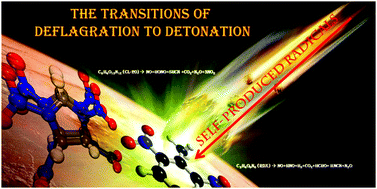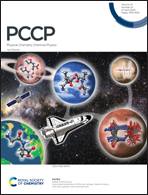CPMD investigation of α-RDX and ε-CL-20: the transition of deflagration to detonation depending on the self-produced radicals†
Abstract
1,3,5-Trinitroperhydro-1,3,5-triazine (RDX) and 2,4,6,8,10,12-hexanitro-2,4,6,8,10,12-hexaazaisowurtzitane (CL-20) are the classic high energy nitramine compounds. Herein, we performed simulations of the overall decomposition pathways of condensed α-RDX and ε-CL-20 by applying the Car–Parrinello molecular dynamics (CPMD) method. Both of them appear to have similar distinct initial decomposition pathways, which are the bond cleavages of N–NO2 bonds. Interestingly, we find that the continuous explosion is nonspontaneous without the participation of self-produced hydrogen radicals of RDX or oxygen radicals of CL-20. Increased radicals are produced gradually with increasing temperature, which activates further entropy-increased steps, resulting in the uncontrollable transition of deflagration to detonation with the formation of NOx, COx and HCN. Herein, we provide a detailed and systematic description of the decomposition for unit-cell α-RDX and ε-CL-20 under increased temperature, which can be summarized as C3H6O6N6 (RDX) → NO + HNO + H2 + CO2 + HCHO + HNCN + N2O and C6H6O12N12 (CL-20) → NO + HONO + 5HCN + CO2 + N2O + 3NO2.



 Please wait while we load your content...
Please wait while we load your content...